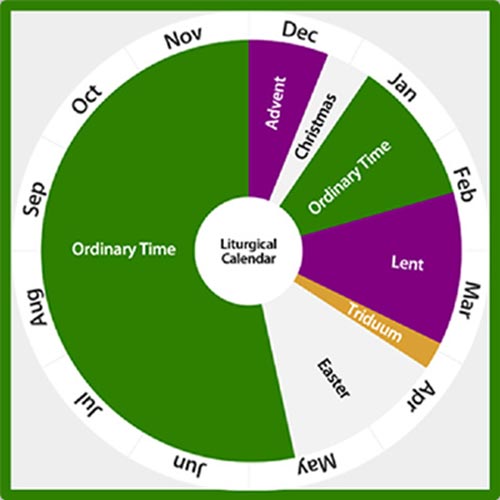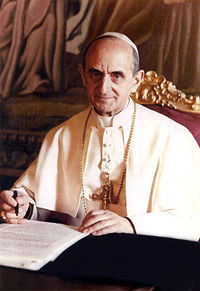
Simon has gone training in Europe.
No points to whoever translated the Latin “Tempus per annum” (meaning “time throughout the year”) into English as “Ordinary Time”. After Vatican II, there was a stroke of genius in organising the Sunday lectionary. The Lent-Easter block of 15 Sundays move back and forth from as early as February 8th to as late as June 20th. But the TOTAL number of Sundays before this Lent-Easter block plus the total number of Sundays after it is essentially constant (varying only with whether there are 52 or 53 Sundays in the year). So the brilliant idea in Sundays reading semi-continuously through a text is that wherever we stop before Lent, we essentially can pick up again after the Easter Season.
This “Tempus per annum” is translated accurately in other languages:
- Spanish: Tiempo durante el año
- French: Temps de l’année
- German: Zeit im Jahr
- Italian: Tempo durante l’anno
- Portuguese: Tempo ao longo do ano
The word “Ordinary” in the English “Ordinary Time” is drawn from “ordinal numbers”: 1st, 2nd, 3rd, 4th… It isn’t at all close to “boring” as so often thought. Many words in English have more than one meaning (Simon has gone training in Europe.)
The post-Vatican II inventors of Tempus per annum focused on the week. Next week is the 5th Week in Tempus per annum/Ordinary Time.
Until 2011, the NZ Anglican lectionary booklet followed this majority Christian way of counting the Sundays. The First Ordinary Week began on the Sunday between 7 and 13 January with the Baptism of the Lord.
But mother Church of England, suffering in the bleak midwinter at this time of year, found a number of festivals to make the time less “ordinary”. They went to counting Sundays of Epiphany until Candlemas on February 2. And then instead of counting “Ordinary time”, they count backwards to Lent (drawing on a Septuagesima, Sexagesima, and Quinquagesima tradition – 3, 2, 1 Sundays before Lent). This coming Sunday (in the CofE) is the Fourth Sunday before Lent.
The Episcopal Church, also in the Northern Hemisphere winter (stretching from the bleak to the less bleak), also doesn’t number its Sundays at this time of year according to Tempus per annum but simply continues counting Sundays after the Epiphany.
In 2011, the NZ Anglican lectionary booklet abandoned naming the early Sundays in the “Tempus per annum” Ordinary 1, 2, 3, as previously. It started following CofE’s Epiphany numbering (but misnaming it – General Synod and every diocesan synod and hui amorangi notwithstanding – Sundays “after THE Epiphany”). But rather than having our own consistent system, it then pasted this CofE system onto the previously-followed post-Vatican II system.
In the Anglican Church in Aotearoa, New Zealand and Polynesia, this coming Sunday is suddenly the “5th Sunday in Ordinary Time”. If this is the “5th Sunday in Ordinary Time”, there is no explanation what happened to the previous four Sundays in Ordinary Time.
I previously thought that it is a (newish) formulary (agreed doctrine/practice) of our Church that, “Ordinary time is the period after the Feast of the Presentation of Christ until Shrove Tuesday, and from the day after the Feast of Pentecost until the day before the First Sunday of Advent.” But this quote is from ‘Notes on the Calendar 2024’. A previous version of this (2002/2004) is listed as being a document “received” by General Synod Te Hinota Whanui. “Received” is the lowest, if unclear, status in our Church – certainly not agreed, like a formulary is.
Ordinary Time only begins after Candlemas (which, being the Anglican Church of Or, “The Presentation of Jesus in the Temple is celebrated either on 2 February OR on the Sunday falling between 28 January and 3 February.”) This year, 2 February was a Sunday – making life easier for us here!
What is happening in our Church is a constant chaotic conflation, a continual patching of one piece onto another (warned against by someone in Luke 5:36!) The Church of England or The Episcopal Church (as just two examples) think through to a systematic, logical way of covering this time of year. NZ Anglicanism is taking mother CofE’s rediscovery of an Epiphany Season ending at Candlemas (appropriate for the Northern Hemisphere bleak mid-winter) and patches it onto Romanophilia for Ordinary Time…. so that the Church of England’s “Ordinary Time” {as per Liturgical Precedence (updated 2014)} beginning after Candlemas suddenly leaps 4 Sundays in NZ Anglicanism to catch up with Roman Catholicism! [CofE, at this point, starts counting backwards to Lent while TEC continues counting Sundays from Epiphany – both logical, whereas NZ’s is not].
I am not in favour of our NZ’s confused, confusing, and conflicting approach to begin Ordinary Time with “The 5th Sunday in Ordinary Time”. I am fine with the majority Christian position which starts Ordinary Time with the Baptism of Christ on the Sunday which falls between 7 and 13 January. That way, we have happily been counting up to this coming 5th Sunday.
Celebrate Candlemas on February 2 by all means – but think twice (or more!) about Sundayising it [What next: move Ash Wednesday to Sunday? Move Christmas to Sunday?]. If your community Sundayises Candlemas, you will end up never reading Luke 4:21-30 nor the great 1 Corinthians 13 nor other significant texts at a Sunday Eucharist…
Continue having an extraordinary Ordinary Time!
Do follow:
The Liturgy Facebook Page
The Liturgy Twitter Profile
The Liturgy Instagram
and/or sign up to a not-too-often email


